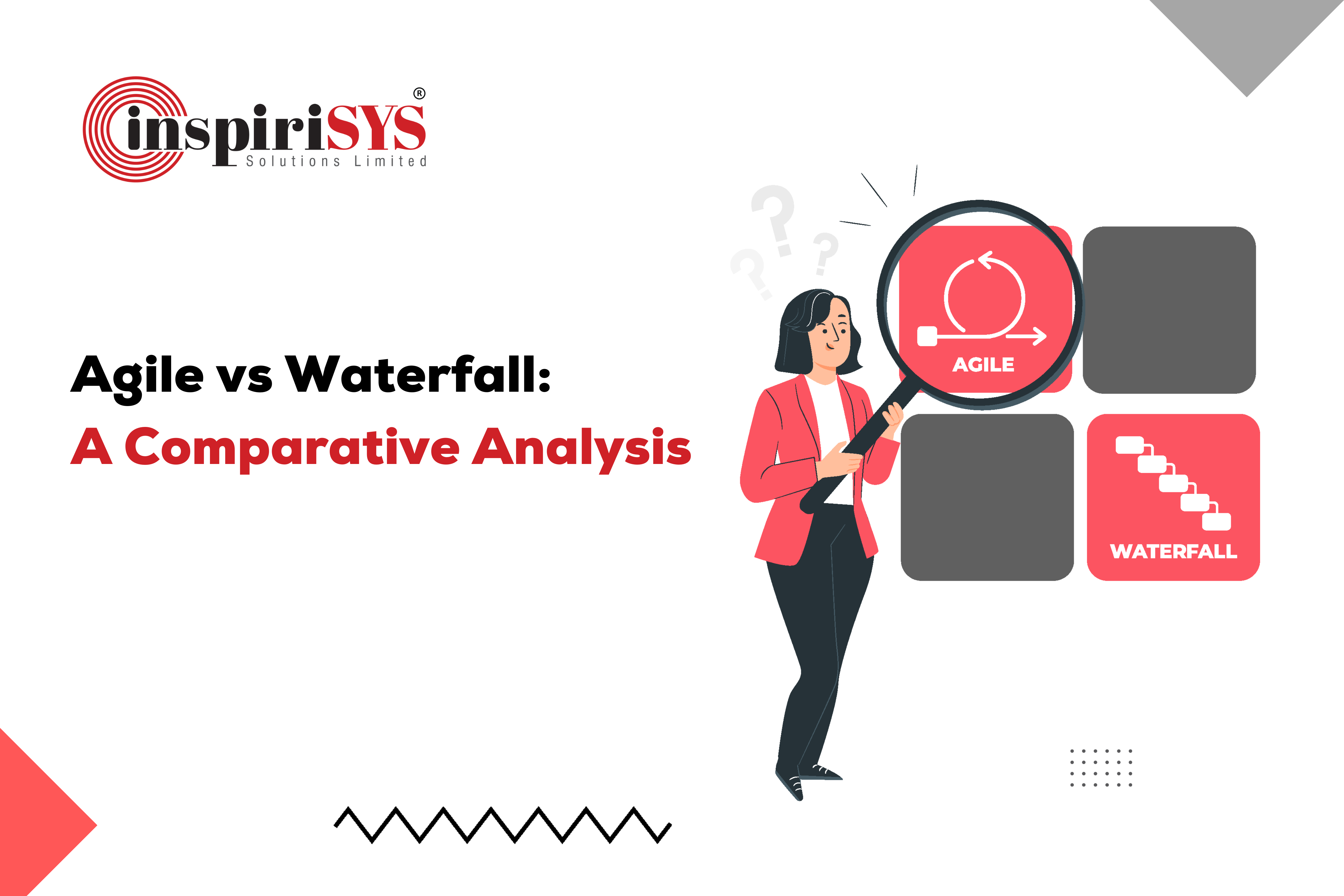The first step to successful project management is deciding on an appropriate management strategy. However, determining the most effective methodology for your business may seem like a daunting task, particularly, due to the availability of various methods.
There are different project management methodologies, and each has its own merits and demerits. Since some of them are more successful in particular industries or types of projects, you’ll need to explore project management methodologies in order to select the one that works best for you. Agile and Waterfall are two popular Software Development methodologies and choosing between them is a crucial step with far-reaching effects.
Before we dive deeper into the topic, let’s understand what is project management and the stages involved in it.
What exactly is Project Management?
A Project Management methodology comprises a collection of techniques, principles, tools, and procedures applied to project management. Project management is different from general ‘management’ which focuses on the time-bound goals and objectives that are achieved within the project’s boundaries.
The stages of project management include:
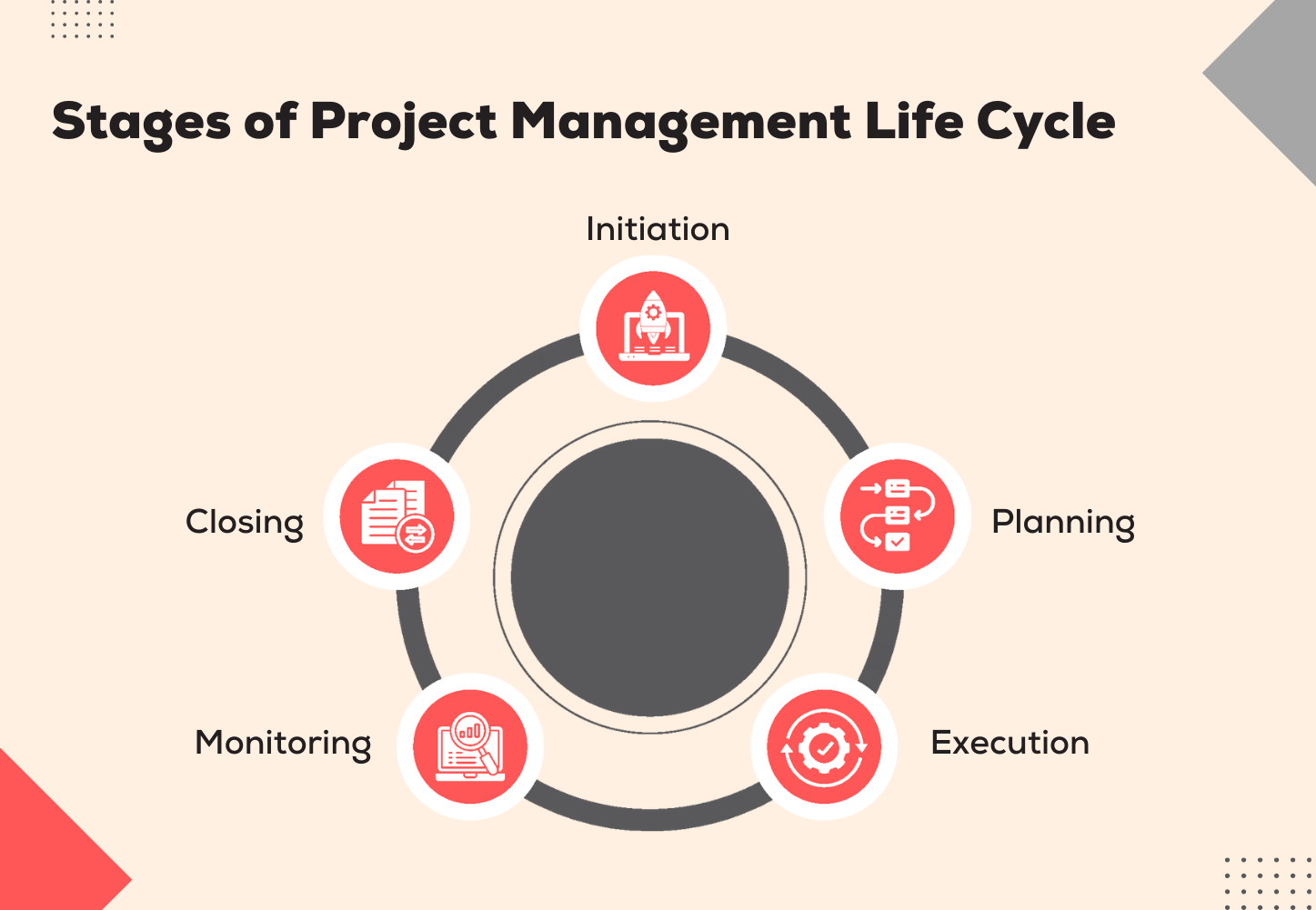
Initiating
The goal of initiating is to decide on business requirements or challenges and engage in brainstorming sessions to determine how the team can fulfil the requirement, and address the challenges. This step creates project objectives, determines feasibility, and defines key project deliverables.
Planning
The planning phase plays a crucial role in establishing a project roadmap that can be followed by the entire team. After receiving approval for the project, the initial document moves to the planning phase. During this phase, the larger projects are broken down into smaller tasks, organize teams, and creates work schedules.
Executing
This phase covers most of the project's activities. Deliverables are built to ensure that the project aligns with the specified requirements. During this phase, the work is maintained and ensured that the work is done according to the initial plan.
Monitoring and Control
This phase focuses on maintaining project alignment by fulfilling the objectives of the project and project deliverables. They involve keeping track of project progress, staying on schedule, and addressing any issues that come up along the way.
Closing
The final phase of the project management lifecycle is the project closure, which represents the end of the project, the release of project resources, and final delivery. The closure phase includes other steps like analysing project performance, and team performance, documenting project closure and conducting reviews.
Now, let’s understand the two most popular software development methodologies - Agile and Waterfall where each exhibit their set of principles, advantages and disadvantages.
All software development projects incorporate common aspects of the lifecycle phase, whether following the agile or waterfall method. This also includes the following:
- Analysis and Design
- Development and Implementation
- Testing and Verification
- Maintenance
Explore the widely used software development methodologies and its lifecycle.
Agile Methodology
The Agile methodology is a project management framework that divides projects into several phases, referred to as sprints. Moreover, it is also recognized as an iterative approach. In this methodology, work and project management are adaptive, progressively developed, and aim for advanced delivery. There is no doubt that this method is fast and flexible.
When referring to this methodology, certain common questions arise – why is agile methodology so popular?
This flexible method employs an adaptive approach, offering project teams an extremely effective way to collaborate and work.
The survey taken by VersionOne released its 12th Annual Report on the State of Agile, suggesting that 49% of business owners employed the Agile method resulting in a 55% growth in productivity.
Gain in-depth knowledge about Agile Adoption with detailed statistics and analysis.
4 Pillars of Agile Methodology
There are four main pillars of the agile model. The list is as follows:
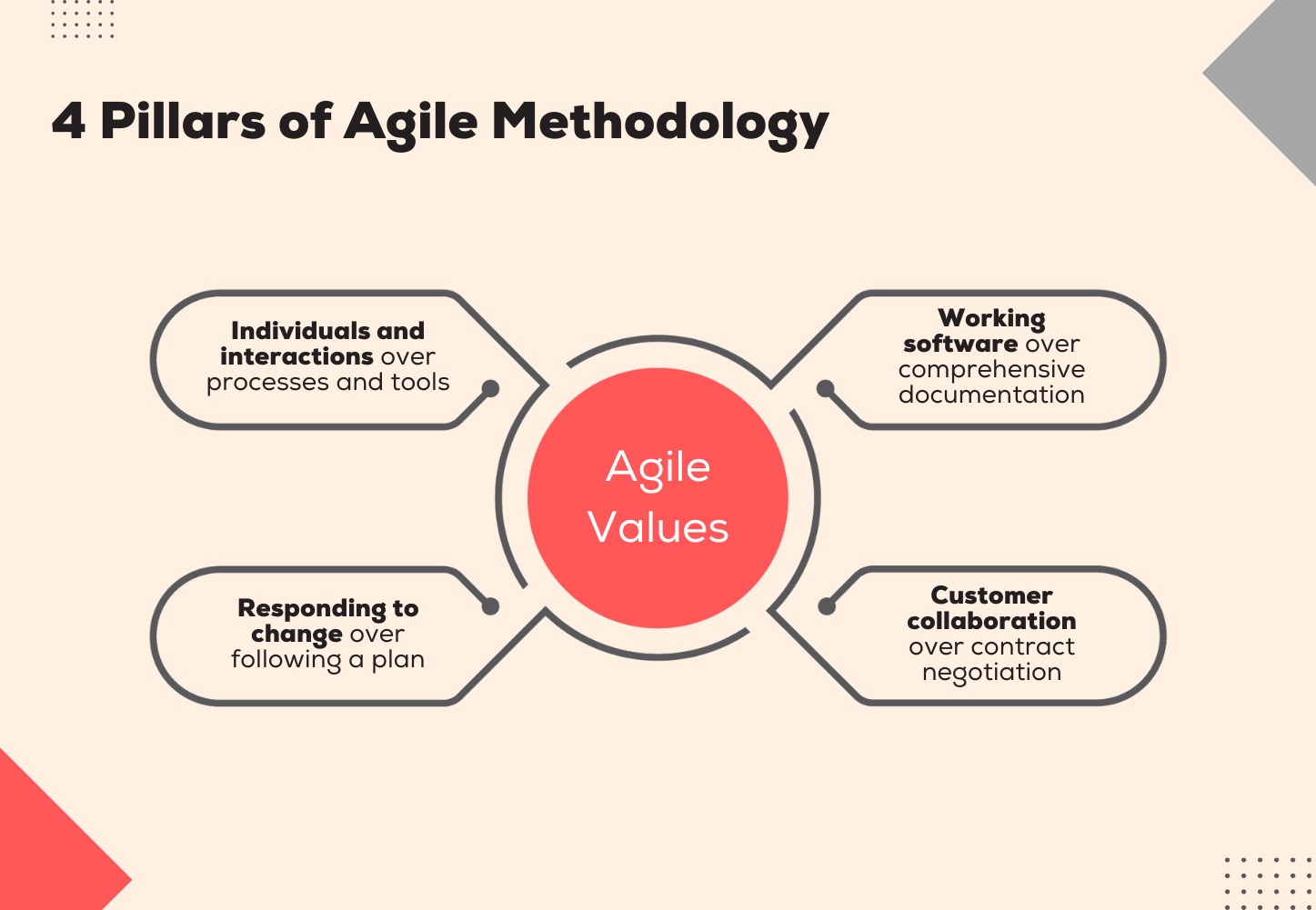
Individuals and Interactions over Processes and Tools
Agile teams prioritize teamwork and recognize the importance of individuals in the process rather than solely relying on tools. The presence of the right team members sets the stage for success. Additionally, tools may prove ineffective if not utilized by the appropriate individuals. Furthermore, effective communication between teams is crucial as it facilitates interactions and enables collaborative problem-solving.
Working Software over Comprehensive Documentation
While developing good software, the primary emphasis is on its functioning. Documentation, on the other hand, is not as critical as the development of the software.
Customer Collaboration over Contract Negotiation
Customers are extremely significant for agile methodology. Consequently, prioritizing customer collaboration is essential to ensure the product aligns with their needs and preferences.
Responding to Change over Following a Plan
As mentioned earlier, the major advantage of agile methodology is flexibility. Without derailing an entire project, quick shift strategies can be used.
12 Agile Principles
In the realm of agile methodology, continuous interaction takes center stage, making the agile model the preferred choice for agile teams. These teams thrive in environments that prioritize flexibility, and to shed light on this concept, we present the agile approach below:
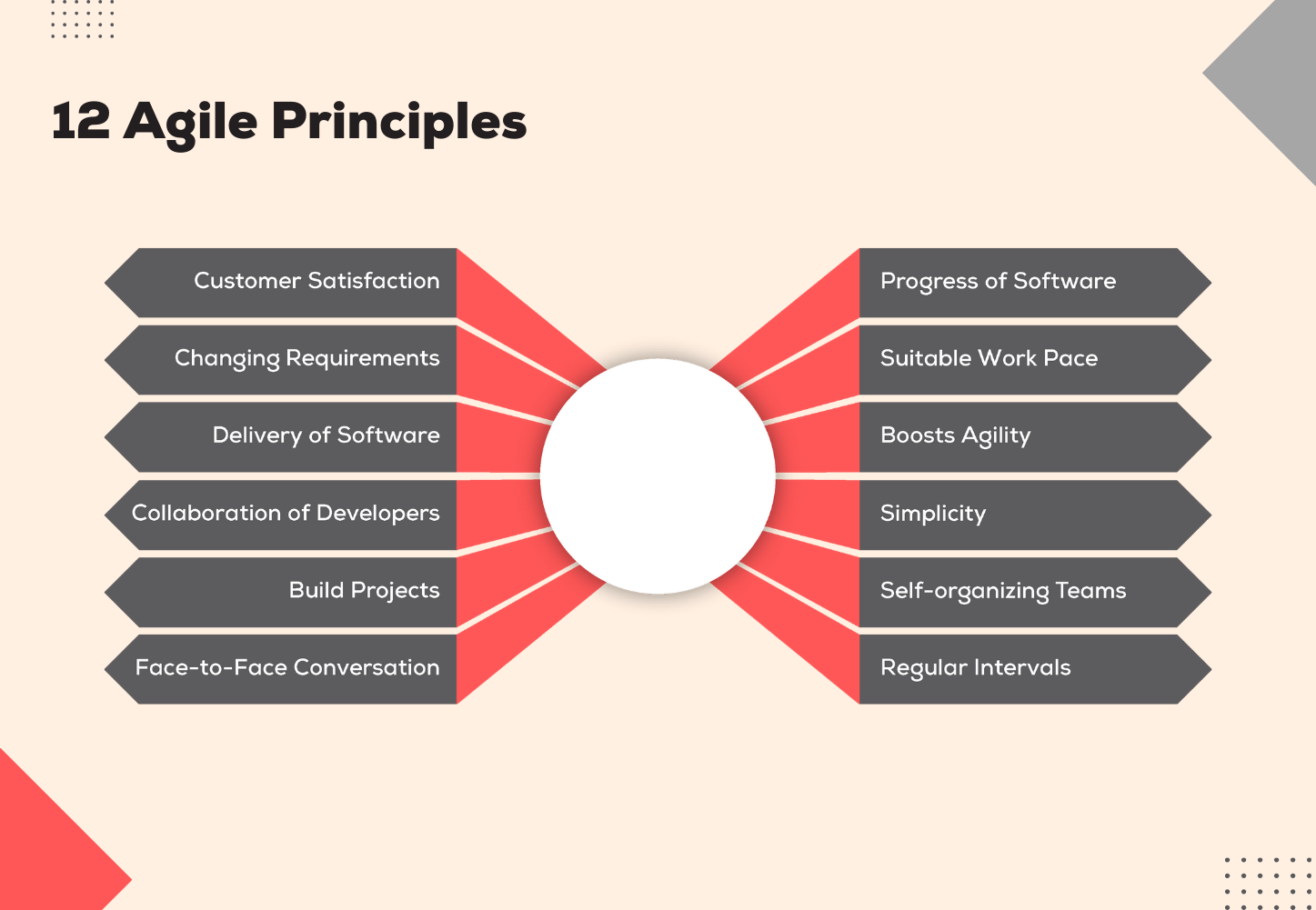
-
Satisfy customers through early, continuous improvement and delivery
Customers should be the first priority and their satisfaction should be of paramount importance. Keeping them engaged and getting their feedback is essential to attain the goal of the project. -
Welcome changing requirements, even in the later stages of the project
Embrace uncertainties! When customers seek a change in the project phase – enforce it. In the world of agile, flexibility is key, and failing to adapt can pose significant risks. -
Deliver working software frequently
Delivering satisfaction and value is crucial, especially in reaching out to customers. An agreement with the team helps to ensure the satisfaction of both parties. -
Business people and developers must work together
‘Unity is strength', as the saying goes, and it resonates effectively within the agile framework. The primary goal is to break down individual projects and promote group collaboration. -
Build projects around motivated individuals
Negotiating doesn’t work in agile methodology, as it can divert your focus from other priorities. Further, this method thrives when teams are well connected to achieve the shared goal. -
To promote face-to-face conversation
Face-to-Face communication is the best way to stay connected as it promotes a better collaborative environment. -
Working software is the primary measure of progress
The project's success depends on making the product the primary focus. The goal is to prioritise functional software over anything else. -
Maintain a suitable working pace
In some cases, agile can be fast-moving. But that shouldn’t cause burnout among the team members. The ultimate goal of the project is to maintain sustainability. -
Continuous excellence boosts agility
If the team develops outstanding code, it sets the stage for building even better things next time, propelling the project forward and helping the team become more agile. -
Simplicity is essential
Agile aims not to overcomplicate things, but to make things easy. This can be achieved through the usage of agile tools. -
Self-organizing teams generate the most value
To achieve the organizational goals, teams should be committed and active in their work. A strong team can work independently and generate the most value. -
Have regular intervals
The practice of having a retrospective meeting provides dedicated time to reflect on their performance and adapt them for the future.
Advantages of Agile Methodology
In the present circumstances, the industry is constantly evolving to keep up with demands and developments. Industries are recognizing the advantages of the agile model and are rapidly adopting. Furthermore, this innovative approach stands as a great choice for rapidly changing environments. Here, we will explain the top benefits of Agile Methodology.
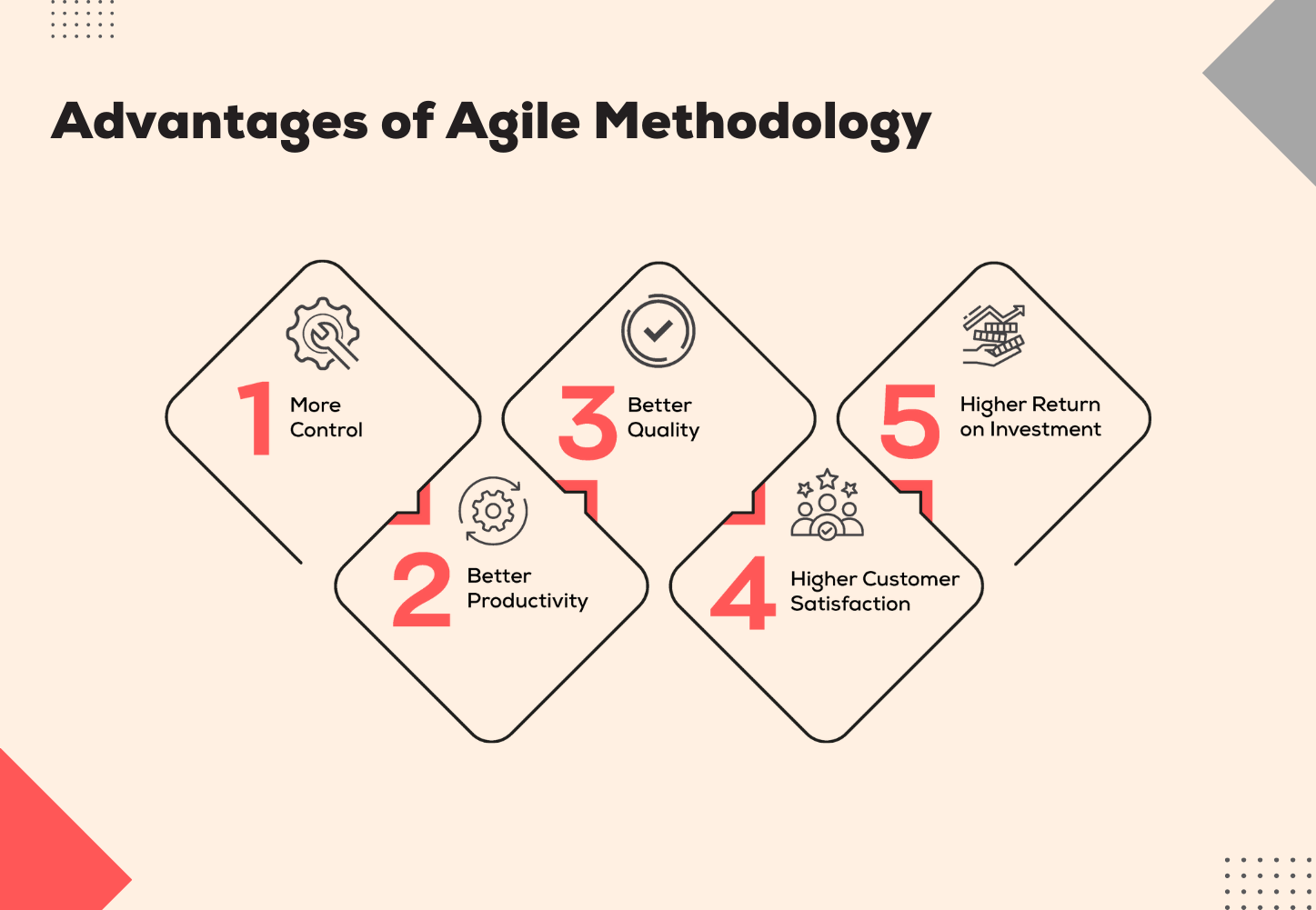
More Control
Gradual development holds immense value for both the customer and the project team. Work can be completed in regular intervals through iterative cycles. Moreover, conducting regular meetings allows for discussions about progress, sharing developments, and, ultimately, working on solutions. Additionally, this method makes the process clearer.
Better Productivity
The agile approach enables projects to be carried out in shorter sprints. Here, changes can be made at any time during the process and the products are rolled out quickly.
Better Quality
One of the significant advantages of the agile methodology, being iterative, is the capacity to swiftly and effectively identify problems and generate solutions. It enables teams to continuously enhance the product.
Higher Customer Satisfaction
Agile puts a strong emphasis on gaining immediate feedback and fostering close collaboration between the customer and the project team to ensure that customer satisfaction remains paramount.
Higher Return On Investment
One of the significant customer advantages of the Agile Methodology is its ability to quickly generate a return on investment (ROI). Its iterative nature ensures that the product is ready for delivery, resulting in valuable benefits. Essentially, Agile's advantage lies in cost reduction and improved customer satisfaction.
Disadvantages of Agile Methodology
Earlier, we saw that the agile method has various benefits. However, some have confronted problems with agile. These problems can stand as a hindrance; thus, it is important to identify and address them. Here is a brief overview of the disadvantages of the agile method.
Lack of Documentation
One of the biggest problems faced by agile teams is the absence of proper documentation. Since larger datasets are compressed into smaller ones, they often lose crucial details. As a result, the team finds it difficult to grasp the data.
High Demands on Time
Another consideration added to the list of agile is time. Teams need to ensure their availability for scheduled meetings, which may disrupt their workflow. Additionally, the extensive level of interaction required can be demanding and potentially strain team members.
Unsuitable for Longer-term Projects
One of the major problems encountered is that agile is not suitable for longer-term projects. The agile iterations are drafted to generate smaller deliverables.
Are you curious to learn whether the waterfall method is suitable for you? Let’s now evaluate the depth of the waterfall methodology.
Waterfall Methodology
Waterfall methodology is otherwise known as the linear approach. Usually, this method follows a sequential order. In the waterfall method, the project is fragmented into a sequence of tasks called the phases.
This method is most relevant for projects where the goal is defined from the beginning. It finds applications in diverse project management contexts, such as IT, software development, construction, and manufacturing.
Phases of Waterfall Methodology
The waterfall approach to software development is a sequential process consisting of 7 phases. Every phase in this model is interlinked and typically, the phases do not intersect.
Here is a description of the 7 phases of the waterfall method.
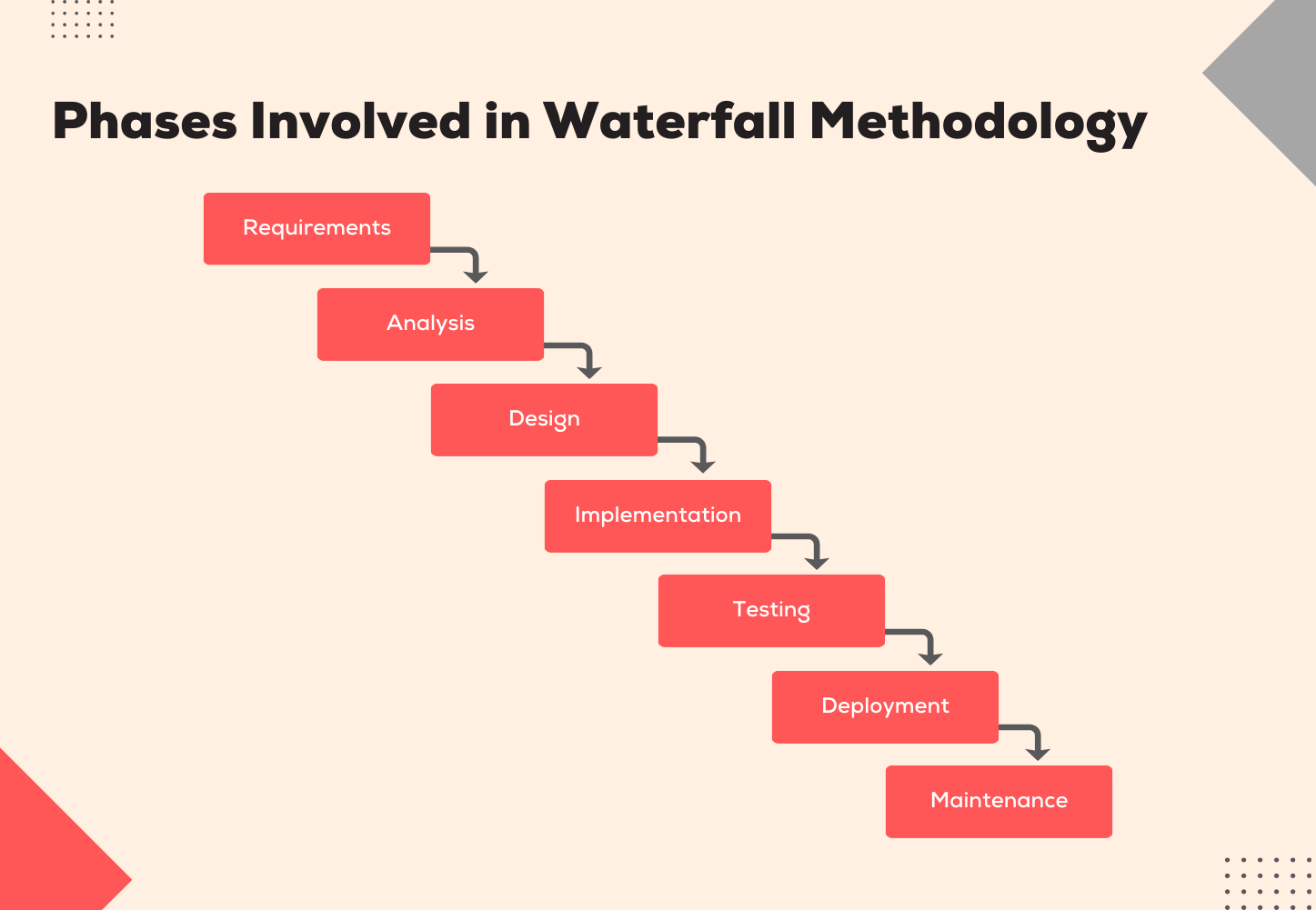
-
Requirement Accumulation
This phase entails gathering information about the project. Collecting the information can be done in several ways from interactive brainstorming to interviewing. The ultimate goal of this phase is to ensure that the project requirements are coherent. -
System Design
This involves designing the software as per the requirements gathered. -
Implementation
In this phase, the coding takes place. The information is taken from the previous stages and the functional product is created. Codes are implemented in smaller pieces and incorporated at the end of the phase. -
Testing
As soon as the coding is done, the testing process begins, during which problems are identified and reported. In case of serious issues, re-evaluation is done. -
Delivery
In this stage, the team completes the product and releases it. -
Maintenance
This is the final phase of the waterfall method. The delivery of the product to the client is done. In case of any issue, the team identifies and resolves it.
Principles of Waterfall Methodology
Typically, each management process considers a set of principles. If you're uncertain whether the waterfall method aligns with your operations, we suggest reviewing the principles it follows. Take a glance to acquire knowledge about the 3 principles of the waterfall method.
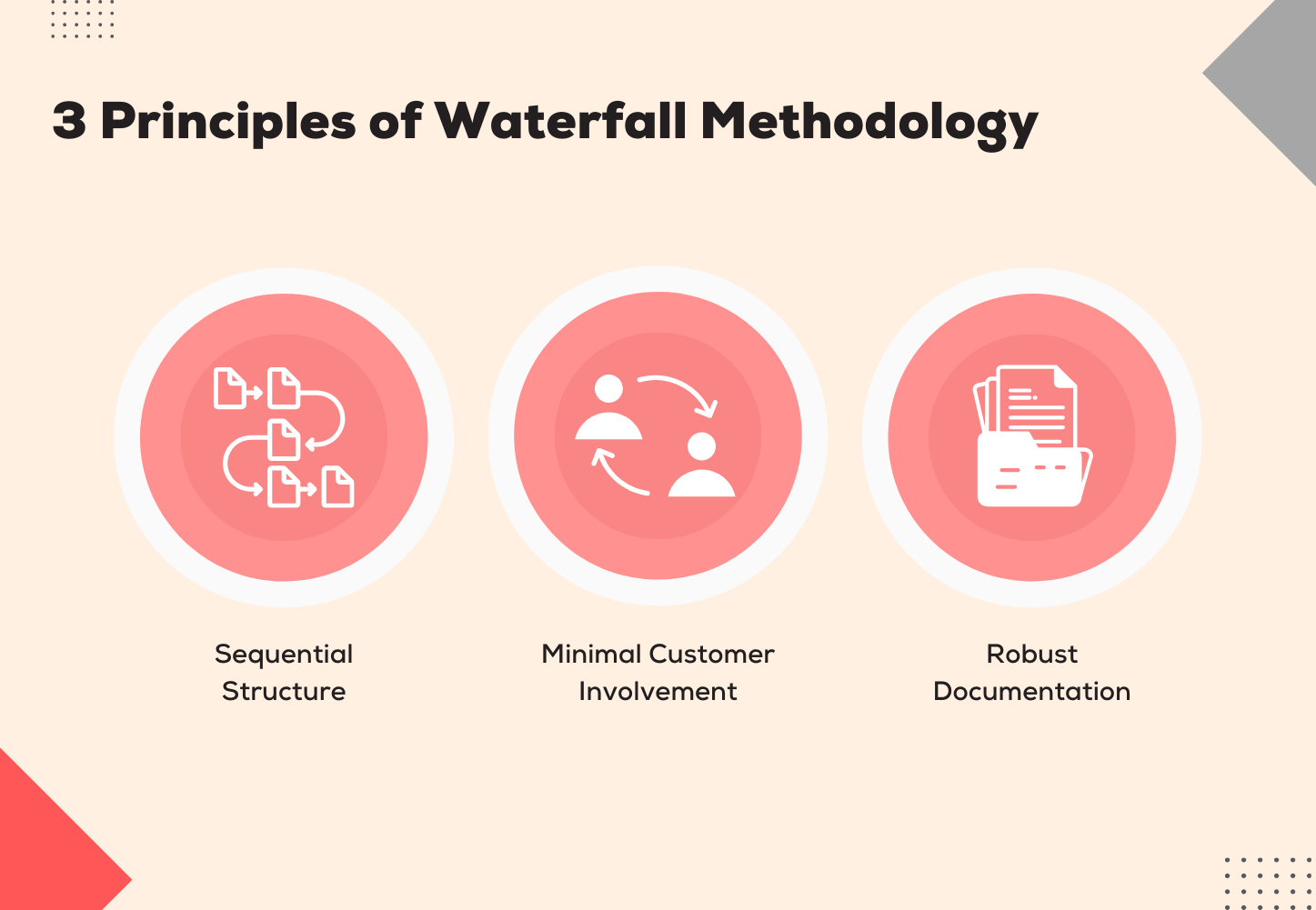
-
Sequential Structure
As said earlier, the waterfall method follows a sequential order. The next phase can be moved only when the current phase is complete. This means that changes cannot be made once we move to the next phase. The only way to get it back is to start the process again. -
Minimal Customer Involvement
A waterfall method demands minimal customer involvement, as the operations start only after the customer’s goal is defined. -
Robust Documentation
This principle follows detailed documentation of the requirements, developments and results. Altogether, every essential detail needs to be covered since there are minimal customers.
The waterfall method will be the perfect choice if these principles are connected in line. Let’s now take a look at the advantages and disadvantages.
Advantages of Waterfall Methodology
-
Presence of a Clear Structure
One of the best features of this model is its clarity and precision. Every phase of this method is so clear that only when it is done, it can be moved to the next phase. -
Smooth Transfer of Information
Information is consistently recorded accurately, as this accuracy is crucial for progression to the next phase. Consequently, thorough documentation is standard practice, thereby ensuring the proper transfer of information stands out as a significant advantage. -
Extremely Stable
Another great advantage of the waterfall method is its greater stability. The structure and design, make this method more stable and robust. -
Early Determination of Goal
The goals of the project can be set beforehand in this method which is considered the biggest advantage. Since all the information is recorded in the first phase, goal setting can also be done at the same time.
Contrary to its advantages, the waterfall method, being a traditional approach, has its own set of disadvantages.
Disadvantages of Waterfall Methodology
-
Delayed Testing
Normally, testing can be done only after all the processes are complete. The chances of uncertainties are high with this method and the only way to remove them is to wait until the testing phase arrives, resulting in delayed testing. -
No Scope for Revision
The inflexible nature of the waterfall method leaves no room for revision. Thus, this is considered the biggest disadvantage nowadays. While plans often evolve, the inflexible structure of this method doesn't accommodate changes. -
Costly and Inflexible
One of the biggest disadvantages of this method is that changes cannot be made once it is moved to the next phase. Reversing to the previous phase is a bit difficult, and quite expensive.
Difference between Agile and Waterfall Methodologies
| Agile | Waterfall |
|---|---|
| Software development process is divided into sprints | Software development process is divided into distinct phases |
| Follows an incremental approach | Follows a sequential pattern |
| Also called the flexible approach | This method is known for its rigidity |
| The test plan is analysed after each sprint | The testing activities are done only at the testing phase |
| Agile is a collection of numerous outlines | In waterfall, the method evolved as a specific outline |
| The requirements can change and evolve | The requirements are definite and cannot be changed |
Closing Thoughts
In a nutshell, both methods offer some benefits as well as limitations and they are used for various projects. However, the agile method is mostly preferred over the waterfall method. Some of its reasons include Team Collaboration, Early Time to Market, Value Creation for Consumers, Regular De-risking.
The best method can be identified according to the project and customer requirements. It is necessary to consider stakeholder needs, the nature of the project and budget constraints. Exercise caution while selecting the right method!
Frequently Asked Questions
1. Does agile cost more than waterfall?
The waterfall method is considered quite expensive than the agile method. In the case of agile, the expense can be decreased by removing the waste and errors, thereby saving expenses.
2. Why is agile needed?
Agile is a much-needed methodology for various reasons that includes Early benefit release, Continual improvement, Responsibility, Variety of ideas.
3. What are the other Software Development Methodologies?
Some of the other Software Development Methodologies include Kanban, DevOps, Lean Development, Scrum, Spiral model, Adaptive software development and so on.
4. What is agile testing?
As the name indicates, agile testing is a software testing process to find out if there are any errors or defects. The testing part is considered fundamental to the development process, ensuring the successful delivery of a high-quality product. The testing process is important to spot and sort out the errors.
5. What is meant by ‘velocity’ in agile?
‘Velocity’ is a measurement unit that measures the time required for a sprint to complete a project. It helps to accurately set timelines. Additionally, measurement and identification of the problems can be done efficiently.


